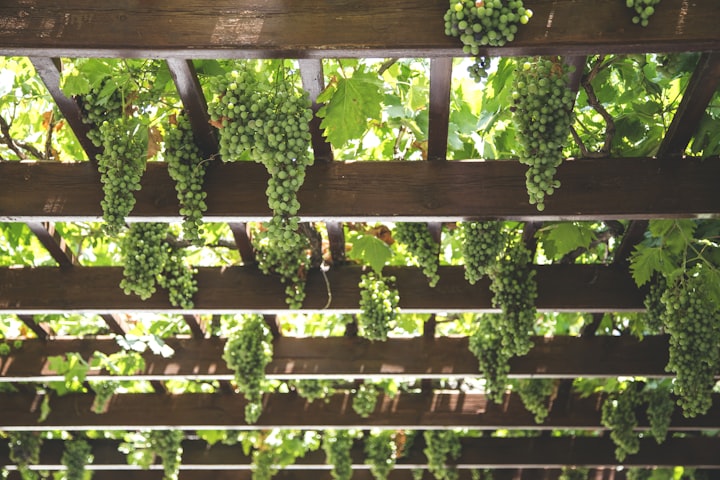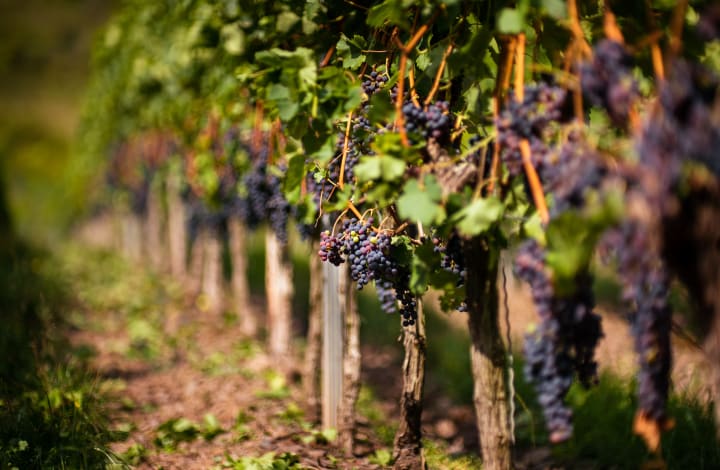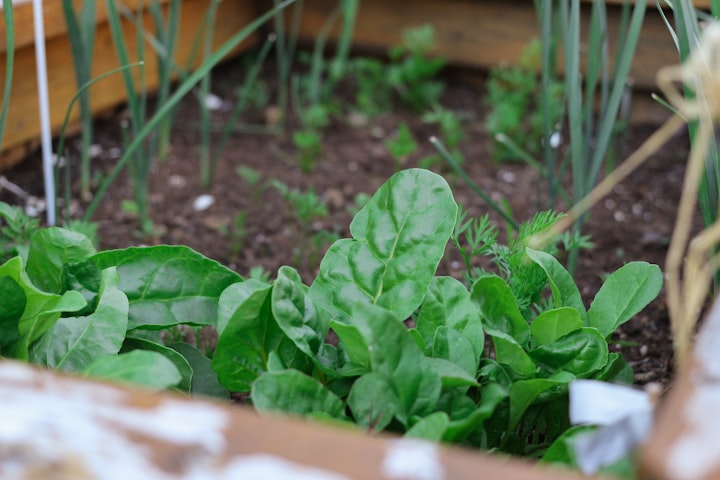In 10 steps.
You too can grow a pot of organic grapes on your balcony that you can eat and enjoy

For those of you who live in the city, whether you are a working person or a full-time housewife when one is faced with a mechanical, repetitive, and boring life every day, your need to seek pleasure for yourself and create a tasteful lifestyle. A balcony full of idyllic poetry will surely bring your life to life. In addition to flowers and plants, you can also plant a potted grape on the balcony, in addition to eating sweet and fresh fruit, more is more of a trust, a life of interest, an idyllic atmosphere, such as potted organic grapes, small farms feel more affordable than planting a pot of flowers.
How to cultivate and manage such a potted grape that is full of warmth and poetry?

The potted grapes are different from the field grapes in terms of management because the potted grapes are small, limited by space, limited absorption of nutrients and all the water and fertilizer need to rely on human supplies, so it is not a simple thing to cultivate a pot of sweet and delicious and pleasing grapes. It is difficult, but not impossible, as long as you understand and master the characteristics of potted plants and grasp the 10 steps in management, you can still grow such a delicious and good-looking pot of grapes, small farms will share their cultivation and management experience with you.
The first step is to choose the "pot" for the potted grapes
The first thing you need to consider when choosing a pot for your grapes is the size of the pot and the material of the pot.
The specifications of the pot. The majority of our residents have limited space on their balconies, so the potted grape plants cannot be too large, which means the pots for the grapes cannot be too large, and the workload of moving the pots and changing the soil must be taken into account. In general, when choosing the size of the pot, it is best to adapt it to the size of the space on your balcony. The most common specifications are pots and buckets with a diameter of 35 to 45cm and a depth of 30 to 35cm, which is the range for growing grapes.
The material of the pot. If you use a new pot, make sure to soak it with water so that it will be more durable. The bottom of the pot must be left with a seepage hole, can be time to exclude the excess water in the container, to prevent the rotten roots phenomenon.
Second, the choice of potted grape varieties
What kind of variety should you choose? The most popular variety of grapes is the Sunshine Rose, which is available on the vine from the time of sugar to the time of full ripeness. The most popular grape variety is the Sunshine Rose, which can be eaten on the vine for nearly two months until it is fully ripe.
How to choose the soil for growing grapes in pots?
The soil quality is very crucial to the success of potted grapes because once the soil is chosen, it cannot be changed at will during the growing period. How should I prepare the soil?
What kind of soil is more suitable for the growth of grapes? The grapes in pots are different from the grapes planted in the field, the nutrients are only supplied by the soil in the pots, if you choose bad soil, it will cause great damage to the growth of the grapes, so what kind of soil should you choose? The clay soil has poor permeability and is prone to become sticky after seeing water, and becomes dry and cracked when there is a shortage of water, which is very unfavorable to the growth of grapes. The sandy soil has fewer nutrients and is very poor in retaining water and fertilizer, so if it is not watered frequently, the grapes are unlikely to survive. So what kind of soil is suitable for clay and sandy soil? This requires the preparation of a special potting soil.
Preparation of nutrient potting soil. The principle of preparing nutrient soil is to facilitate fertilization, water retention, organic matter, good air permeability, and a slightly acidic soil pH value. The ratio of "3, 3, 3" is the simplest way to prepare such a nutritious potting soil, that is, one-third of cooked chicken manure, sheep manure and other manure, field soil, and sand. In addition, you can add a small amount of calcium superphosphate or hoof horn powder, bone meal, and other substances.
Fourth, how to cultivate potted grapes?
Root pressing method. There are various ways to grow grapes in pots. You can directly implant the seedlings into the pots, or you can set the bottom parent branches of the grapes into the pots through the leaky holes at the bottom of the pots to let them slowly take root, or you can take cuttings directly into the pots. The most used in small farms is to cultivate the bottom mother branch of the grapes through the leaky holes at the bottom of the pots into the pots. After putting the annual shoots into the pots, the prepared potting soil, layer by layer, is filled with 8 percent soil and then watered sufficiently. It is best to cultivate in June and July for the fastest rooting results. The advantages of this cultivation method are a high survival rate, vigorous trees, and low stress, so it is also one of the best ways to breed potted grapes, but this method also has certain disadvantages, high workload and a small amount of propagation.
Propagation by cuttings. Another common method is the cuttings method, which is suitable for propagation on a large scale. Choose a new branch of 1 year old, cut it into a 20 cm long strip, leave at least two buds, soak it upright in rooting powder water for about 5 hours, then insert it into the cultivated soil and water it thoroughly. Observe logistically and when you see the soil dry, spray some water, and it will take about 1 month for the roots to sprout.
V. How to shape grapes in pots
Grapes are very fast-growing and can normally bear fruit in the second year after cultivation. Unlike in-ground grapes, potted grapes can be coiled, so it is more important to prune and shape them. The most common shapes are these, which you can manage by pruning according to different situations.
No matter which method you use, you have to master the principle of pruning and keep it short, not long, because the space for potted grapes is small and nutrition is limited, so the branches have to be cut heavily compared to in-ground grapes.
The single branch upright method. This method is simple and practical, which is to leave only one main stem, the rest of the new tips soon after sprouting all erased, when the main stem grows to about half a meter high, hit the top to promote its axillary buds forked growth, and then grow out of the secondary tips, leaving the top one of the most vigorous growth of a branch instead of the main branch upward, the rest of the secondary tips issued by the 2 to 3 branches, in the growth of 2 to 3 leaves, as a plucking treatment to prevent the secondary tips from growing crazy and consuming nutrients. In this way, the secondary tips can be fruitful the following year.
Layered shaping method. When the main vine grows to 80~100cm, the top of the vine is removed and the secondary vine is selected according to the growth of the tree, the size of the pot, and the size of the balcony space.
Cross-shaping method. This method is to leave a trunk, the rest of the secondary tips to take a cross-growth way to choose to stay, that is, about 30 centimeters from the mouth of the pot to leave the first secondary tips, up every 30 centimeters in the direction of the first secondary tips and then leave the secondary tips, each secondary tip grows to about 3 leaves that is plucked heart treatment, the top of the secondary tips to leave about 6 leaves plucked heart, the main trunk to about 1 meter when the tip.
Six, the choice of frame shape
After all, potted grapes are small in space, and grapes are vine plants with soft branches, so they need to be supported at the right time, especially after the fruiting, a good pot of grapes, the fruiting volume can reach more than 10 pounds, such a weight, do not rely on the support of the bracket is easy to collapse phenomenon. So what kind of stand and frame shape should be chosen? A pleasing stand shape is like a person wearing clothes for the same reason, making people feel particularly comfortable. In general, these two types of shelf shape is used more.
The umbrella shape. This shape is the most suitable for the natural growth of grapes, especially for grapes with an upright trunk.
The flower basket shape. This type of frame is more stable and suitable for the layered shaping method and cross shaping method of grape frame shape.
Water and fertilizer management for potted grapes
It is important to keep up with the water and fertilizer management of potted grapes, neither too much nor too little, too much is prone to rotten and burnt roots, and too little is prone to yellow and fallen leaves due to insufficient water and fertilizer. So how to manage it?
Fertilizer management. The fact is that you can find a lot of people who are not able to get a good deal on a lot of things. In the process of fertilization, you should also look at the leaves and fertilize them. By observing the changes in the leaves, you can understand which kind of fertilizer the grapes lack and target the fertilizer. If the leaves appear light-colored and small, and the grains are small, it means that the fertility is not enough and some nitrogen fertilizer needs to be added. If the leaves appear yellow or even appear to fall off, there is a greater possibility of zinc deficiency, and if the fruit color is light and the grains are light in color at maturity, some potassium fertilizer needs to be applied.
Watering management. It is best to follow a principle in watering flowers or fruits in pots, watering should be thorough, remember not to water semi-permeable, and less watering during the flowering period to prevent the phenomenon of fruit drop, and in the fruit growing period, we should combine with fertilizer to water thoroughly. Watering should be done with stored water, not with well water or tap water. In summer, watering should be done in the morning and evening, avoiding the heat of the day. Water thoroughly once before the onset of winter and keep the potting soil moist throughout the winter, but keep watering under control to ensure overwintering.
Pictures
Eight, the management of the fruit
In the management of fruit must control the amount of fruit and potting soil nutrition to adapt to the problem, management, mainly taking into account the amount of fruit, the amount of fruit of a fruit branch, fruit shaping, and other aspects.
Fruiting volume. The fruiting volume of the whole plant is determined by the size of the tree, the strength of the tree, the age of the tree, and several other aspects.
Fruiting capacity of single fruiting branches. In general, the amount of fruit spikes of a single fruiting branch is kept at 1 to 2, not too many, so that the nutrition can not keep up.
Fruit shaping. When the grains grow to the size of green beans, the front end of the fruit spikes, and small grains will be cut off in time to avoid the appearance of large and small grains, which affect the shape of the fruit.
9. Pruning of potted grapes
Like field grapes, potted grapes also require winter pruning during the deciduous period and pruning during the summer growth spurt.
Winter pruning of potted grapes. In general, in winter pruning, except for the extension branches, the rest of the branches should be cut short.
The main points of summer pruning. Summer pruning needs to be more delicate and diligent. The secondary growth of fruit-bearing trees is generally weak and should be repeatedly plucked based on retaining 2 to 3 leaves, and the number of fruit spikes on fruit-bearing branches should generally be kept at 1 to 2 spikes.
X. Management of pest and disease control
The pests and diseases of potted grapes are relatively few, but they are not free from disease, in general, the common pests and diseases are mainly harmful to young fruits, new shoots
In general, the common pests and diseases are powdery mildew, black pox, anthracnose, and downy mildew that affect the leaves. When these diseases occur, Bordeaux or carbendazim can be used to control them; when aphids occur, 800-1000 times the amount of Legal can be used to control them.
Conclusion: To cultivate a potted organic vine on the balcony, as long as you do these 10 steps and manage it carefully, you will be able to produce bunches of sweet and delicious grapes, which will allow your family to eat delicious grapes and add a sense of rustic atmosphere to the whole family and increase the joy of life.
Let's talk about the people and things of agriculture and share the practical experience of planting and farming, welcome to pay attention.
Disclaimer
About the Creator
caldwell benis
Success = hard work + the right approach + less empty words






Comments
There are no comments for this story
Be the first to respond and start the conversation.